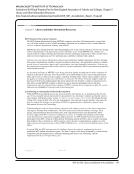14 · Survey Results: Executive Summary
Survey respondents were asked to indicate what
quantitative library data they reported for accredita-
tion purposes. Not surprisingly, libraries contributed
data to demonstrate institutional commitment, such
as print and online holdings data, facilities and equip-
ment, and financial data. They also contributed data
that demonstrate engagement, such as circulation and
interlibrary loan data, library instructional sessions
conducted, and reference transactions. Most respon-
dents (71%) indicated they provided evidence of staff
qualifications and expertise, ranging from academic
credentials to library faculty journal editorship and
editorial board membership.
The survey also asked what methods the library
uses to collect qualitative data for accreditation pur-
poses, specifically those types identified by Leonard
Berry.2 Eighty-one percent reported using a total
market survey such as LibQUAL+®. Focus groups
are the next most frequently employed method, with
customer advisory panels and other qualitative meth-
ods being used less frequently. Only one respondent
reported using transactional surveys, even though
these types of surveys have the broadest possible
applications (e.g., in person reference transactions,
online reference transactions, use at the conclusion
of a website transaction, completion at the end of an
instructional session, etc.) and are, relatively speak-
ing, the easiest to construct.
Overall, 31 of the survey respondents (76%) indi-
cated they used quantitative devices to collect data
for accreditation purposes, compared to only 18 (44%)
that use qualitative tools to demonstrate library im-
pact for accreditation reporting.
Conclusion
As one respondent noted, “Library staff do not always
know how library-contributed data is summarized
for inclusion in [a] final report to the agency. Library
staff have also noted that often the questions asked
by the accrediting agency about library resources and
services seem ‘out of date’ with current collection and
service models.” The data collected in this survey sup-
ports that perspective those accrediting agencies that
ask libraries to provide data still tend to ask for a report
of volumes or subscription counts. However, another
respondent noted, “Over the past several years, we’ve
seen a trend away from a lot of very detailed questions
(e.g., about numbers of volumes) to a more open-ended
‘describe library resources’ sort of approach. When
we meet with reviewers, we are hearing slightly less
emphasis on collections overall (though more empha-
sis on off-campus access to e-collections) and more
emphasis on facilities than in the past, e.g., questions
about ample study space—including availability of
separate spaces for group work and quiet study, 24-hr
access to the building, adequacy of wireless service.”
Table 3: Methods Used to Collect Qualitative Data
6%!
6%!
13%!
31%!
50%!
50%!
69%!
81%!
0%! 20%! 40%! 60%! 80%! 100%!
Transactional Surveys!
Employee Field Reporting!
Service Reviews!
First/Graduating Yr Surveys!
Other!
Customer Advisory Panels!
Focus Group Interviews!
Total Market Surveys!
Survey respondents were asked to indicate what
quantitative library data they reported for accredita-
tion purposes. Not surprisingly, libraries contributed
data to demonstrate institutional commitment, such
as print and online holdings data, facilities and equip-
ment, and financial data. They also contributed data
that demonstrate engagement, such as circulation and
interlibrary loan data, library instructional sessions
conducted, and reference transactions. Most respon-
dents (71%) indicated they provided evidence of staff
qualifications and expertise, ranging from academic
credentials to library faculty journal editorship and
editorial board membership.
The survey also asked what methods the library
uses to collect qualitative data for accreditation pur-
poses, specifically those types identified by Leonard
Berry.2 Eighty-one percent reported using a total
market survey such as LibQUAL+®. Focus groups
are the next most frequently employed method, with
customer advisory panels and other qualitative meth-
ods being used less frequently. Only one respondent
reported using transactional surveys, even though
these types of surveys have the broadest possible
applications (e.g., in person reference transactions,
online reference transactions, use at the conclusion
of a website transaction, completion at the end of an
instructional session, etc.) and are, relatively speak-
ing, the easiest to construct.
Overall, 31 of the survey respondents (76%) indi-
cated they used quantitative devices to collect data
for accreditation purposes, compared to only 18 (44%)
that use qualitative tools to demonstrate library im-
pact for accreditation reporting.
Conclusion
As one respondent noted, “Library staff do not always
know how library-contributed data is summarized
for inclusion in [a] final report to the agency. Library
staff have also noted that often the questions asked
by the accrediting agency about library resources and
services seem ‘out of date’ with current collection and
service models.” The data collected in this survey sup-
ports that perspective those accrediting agencies that
ask libraries to provide data still tend to ask for a report
of volumes or subscription counts. However, another
respondent noted, “Over the past several years, we’ve
seen a trend away from a lot of very detailed questions
(e.g., about numbers of volumes) to a more open-ended
‘describe library resources’ sort of approach. When
we meet with reviewers, we are hearing slightly less
emphasis on collections overall (though more empha-
sis on off-campus access to e-collections) and more
emphasis on facilities than in the past, e.g., questions
about ample study space—including availability of
separate spaces for group work and quiet study, 24-hr
access to the building, adequacy of wireless service.”
Table 3: Methods Used to Collect Qualitative Data
6%!
6%!
13%!
31%!
50%!
50%!
69%!
81%!
0%! 20%! 40%! 60%! 80%! 100%!
Transactional Surveys!
Employee Field Reporting!
Service Reviews!
First/Graduating Yr Surveys!
Other!
Customer Advisory Panels!
Focus Group Interviews!
Total Market Surveys!
























































































































































































